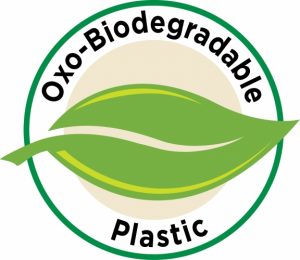The science: Oxo-degradable plastic films
 The term ‘Oxo-biodegradable’ is a hybridisation of two words, oxidation and biodegradable. It clearly defines a two step process initiated by an additive to degrade the polymer chain (break up) and make it available for biodegradability within the environment when a treated item has finished its useful life.
The term ‘Oxo-biodegradable’ is a hybridisation of two words, oxidation and biodegradable. It clearly defines a two step process initiated by an additive to degrade the polymer chain (break up) and make it available for biodegradability within the environment when a treated item has finished its useful life.
Oxo-Degradable film is designed specifically to address the issue of plastic waste that gets into the environment and cannot be realistically collected. This has been used in numerous PE and PP applications for many years and now.
Oxo-Bio Assimilation Process
- Oxidisation begins once exposed for at least 48 hours to sunlight and/or high temperature with the presence of oxygen
- Oxo-degradable additives accelerate molecular fragmentation to break down the plastic polymer chain
- When the molecules are <40,000g/mol, biological assimilation can occur
- By the action of fungi and bacteria fragments are transformed into biomass, CO2, H20 & Methane
FREQUENTLY ASKED QUESTIONS
What are Oxo-degradable Plastics?
Oxo-degradable plastics are conventional plastics such as polyethylene, polypropylene and polystyrene to which is added a proprietary mixture that accelerates the breakdown of the chemical structure of the plastic.
These plastics are the main ones used in a variety of disposable packaging applications. The resultant breakdown products are then amenable to conversion by microorganisms, for which these products are an energy source or food, into carbon dioxide and water; thereby returning otherwise intractable plastics to the ecosystem.
It is questionable whether the oxidized small fragments can be colonized and assimilated by microbes and therefore be described as biodegradable. Is it true?
Biodegradation of oxo-degradable plastics can occur after they have fragmented and then proceed very slowly, at a rate many times slower than that of a compostable plastic.
Independent third party testing and field trials in several countries have proven that they do. Those available today are amenable to composting but, because they do not biodegrade at the very high rate prescribed by ASTM 6400.
Are the additives in Oxo-biodegradable Plastics harmful to people or the environment?
No. The active ingredient in oxo-biodegradable products, a transition metal salt (often of cobalt), is used at very low levels. Cobalt is a micro-nutrient essential for life. Studies have shown that composts made from oxo-biodegradable bags are not toxic to sensitive plant and animal organisms. Oxo-degradable plastics have also been determined to be safe for use as food packaging.
Won’t packaging using this technology disintegrate when it is being used?
No. The additives used do not initiate the degradation process; they make it go faster once it has started. Heat and/or sunlight are required to initiate degradation and there has to be oxygen present. Products using this technology are engineered to have shelf lives of at least a year or two and useful lives of months to years, depending on end use. They are designed, and have been shown, to begin to degrade when they are discarded into common disposal environments (landfill, litter, compost) which are warm and/or sunny and have available oxygen.
